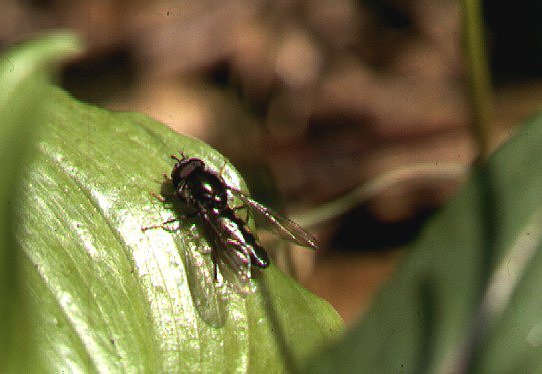1.a.
Males -> 2
1.b. Females not changed: Nielsen (2004) only keys out males.
2.a. Tibia 1 slender, marginally increasing in width from base to apex, at apex cylindrical or flattened -> 3
2.b. Tibia 1 strongly broadened and flattended towards apex -> not changed, continue the key in the book on item 20.
3.a. Basitarsus 1 slender, at least twice as long as broad, and often not broader than tip of tibia 1 -> 4
3.b. Basitarsus 1 broadened, at most twice as long as broad, and distinctly broader than tip of tibia 1 -> not changed, continue the key in the book on item 14.
4.a. Femur 1 at the apex with a distinct, long, curled hair; apex of tibia 1 and basitarsus cylindrical [remark: if tibia and basitarsus 1 are cilindrical, but femur 1 lacks the long curled hair, see Melanostoma!] subgenus Pachyspyria -> 5
4.b. Femur 1 without such a curled hair; apex of tibia 1 and basitarsus flattenend -> not changed, continue the key in the book on item 8.
5.a. Tergites 2, 3 and 4 with spots -> 6
5.b. Tergites all black with bluish reflections, without spots -> Platycheirus immaculatus OHara
6.a. Antenna: 3rd segment less than 2 times longer than broad -> 7
6.b. Antenna: 3rd segment elongate, more than 2.2 times as long as broad -> Platycheirus subambiguus Nielsen 2004
7.a. Femur 1: posterolaterally, near apex (just before curled hair) with a row of hairs wich taper towards their apices and which approach the length of the curled hair (in curled state) -> 8
7.b. Femur 1: posterolaterally, near apex (just before curled hair) with a row of strong bristles of uniform thickness, which narrow rather abrubtly towards thair apices and which are distinctly shorter than the curled hair -> 10
8.a. Eyes meeting for a distance which is at least as long as the distance between the ocelli; facial knob and mouth edge only slightly produced; femur 1 yellow or greyish-yellow, occasionally with a brownish stripe baso-ventrally; tergites 2-4 with yellowish spots -> 9
8.b Eyes meeting for a short distance only, shorter than the distance between the ocelli; facial knob and mouth edge somewhat produced; femur 1 (and 2) black except for knees; tergite 2-4 with blue-grey spots. -> Platycheirus altomontanis Merlin and Nielsen 2004
Note: short and stout species
9.a. Tibia 1 short haired, usually posterolaterally with 1-2 bristles which are rarely longer than the thickness of the tibia; femur 1 postero-laterally with long hairs which are about as long as the maximum width of the femur; alula: tip rounded -> Platycheirus transfugus Zettersted
9.b. Tibia 1 postero-laterally with a few long hairs, the longest of which are longer than the thickness of the tibia; femur 1 postero-laterally with long hairs, the longest exceeding the width of the femur; alula: tip less rounded -> Platycheirus clausseni Nielsen 2004
10.a Haltere: knob greyish brown -> 11
10.b Haltere: knob yellow -> 12
11.a. Femur 1 yellow or greyish yellow; wing: basal cells bm and br bare, without microtrichia -> Platycheirus ambiguus Fallen
11.b Femur 1 black with yellow knee; wing: basal cells bm and br almost completely trichose -> Platycheirus lundbecki Collin
12.a. Tibia 1: short haired, normally without bristle like hairs postero-laterally; eyes: meet at an angle of 100 degree -> 13
12.b. Tibia 1: postero-lateral with bristle-like hairs; eyes: meet at an angle larger than 100 degree -> 14
13.a. Ocellular triangle, thorax and base of tergite 1 and 2 metallic blue -> Platycheirus abruzzensis Van der Goot 1969
13.b. Ocellular triangle, thorax and base of tergite 1 and 2 charcoal grey -> Platycheirus meridimontanus Nielsen 2004
14.a. Femur 1 yellowish, at least antero-dorsally; tibia 1 postero-laterally with long hairs, the logest reaching beyond the apex of the tibia -> 15
14.b. Femur 1 black except for knees narrowly yellow; tibia 1 postero-laterally with hairs which do not reach beyond the apex of the tibia -> 16
15.a. Frons covered by greyish pollinosity; femur 2 postero-laterally with rather long black hairs, the hairs near apex are longer than the thickness of the femur; metatars 3 swollen, about 1.5 times thicker than the apex of the tibia; spots on tergite bluish grey to obscure orange -> Platycheirus goeldlini Nielsen 2004
15.b. Frons covered by brownish pollinosity; femur 2 postero-laterally with rather long black hairs, which are not longer than the maximum thickness of the femur; Metatars 3 less swollen, only slightly thicker (1.2 times) than apex of the tibia; spots on tergites rather small, orange brown -> Platycheirus brunnifrons Nielsen 2004
16.a. Tibia 1 postero-laterally with a few isolated bristles; tergite 2, 3 and 4 with a pair of shiny, bluish or bluish grey metallic spots, all spots situated at the bases of the tergite -> Platycheirus caesius Nielsen 2004
16.b. Tibia 1 postero-laterally with a row of long adpressed black bristles, the longest reaching the apex of the tibia; tergite 2, 3, and 4 with a pair of dull grey spots, the spots on tergite 3 isolated from the anterior margin of the tergite -> Platycheirus lundbecki Collin

